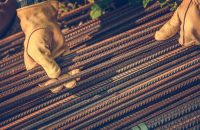
A deformed bar is a type of steel reinforcing bar that is designed to be deformed by mechanical or hydraulic means before installation. They can be used where conventional reinforcement would otherwise fail due to lack of space, and they provide high-quality solutions in difficult situations.
The quality standards for the manufacture and use of deformed bars vary from country to country, but the most common quality standards set for their manufacture and use are seen in most if not all Standards Organisations of different countries.
These same local standards are all overseen and maintained by the International Standards Organization (ISO).
What are Deformed Bars?
Deformed bars are steel bars that have surface projections and indentations within them (sometimes referred to as ‘ribs’) thus enabling them to have a greater bond strength and overall friction in construction when compared to the traditional smooth and round rebars.
Deformed bars, and all types of reinforcing bars in general, are commonly used in construction to set up the skeleton or the foundation of the structure before anything else is put into motion.
Because of this purpose, deformed bars have to be extremely strong and durable in order to withstand tension loads and pressure throughout the construction process.
Deformed Bar materials
There are many types of materials that are used in the creation of deformed bars. The quality standards are governed by the relevant “Standards Organisation” of a country.
Carbon Steel
Often referred to as a “black bar,” carbon steel deformed bars is the most common type of bar used in construction.
The quality standards for manufacture and use of deformed bars vary from country to country
It is used in almost all types of construction. However, it is not recommended for use in structures exposed to high levels of humidity, as carbon steel tends to corrode faster than other materials.
Stainless Steel
Stainless steel is another common material used in deformed bars. It is more commonly used where carbon steel is not advisable such as in places where corrosion is more likely, or where access to undertake repairs may be difficult.
Stainless steel bars can be more expensive than other types of materials.
Galvanised

The advantages of using galvanised bars are that they are highly resistant to corrosion, compared to carbon steel and stainless steel.
They are not as economical as other steels.
Galvanised bars are perfect for structures that are constantly exposed to water and humidity.
Epoxy-Coated
As epoxy-coated deformed bars are corrosion-resistant, they are specifically suitable for structures that will be in contact with saltwater. Aside from being expensive, there are low-quality imitation epoxy-coated rebars in the marketplace, so ensure that you source them from a trusted and reputable supplier.
Glass Fibre
A glass fibre material will not corrode. However, the price for glass fibre materials is much higher, the cost can be as much as ten times that of epoxy-coated rebars.
The bottom line
It is important that you use the correct type of rebar in your project. Some may be a higher cost, but choosing the right one will pay off, resulting in less maintenance, greater stability and overall better quality.
Do you have any existing projects you need further expert advice on, or are you planning to start a new one? Let us provide you with the best advice by reaching out to us here!


